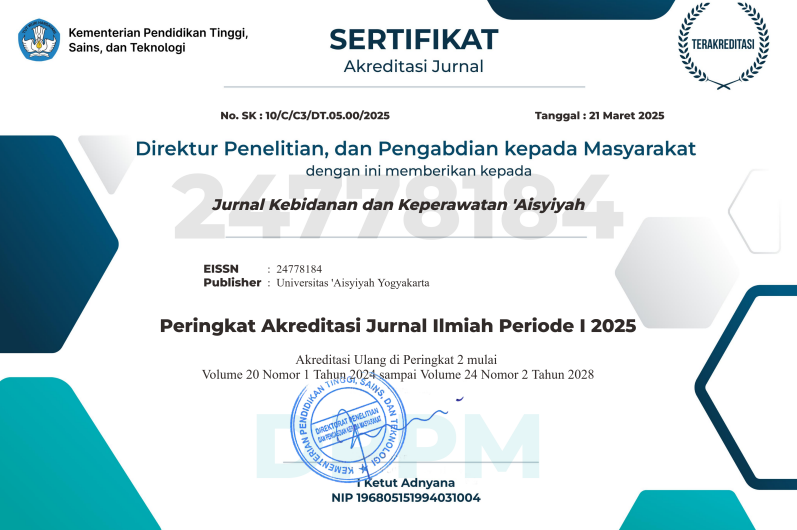Pengaruh pembelajaran e-learning terhadap peningkatan motivasi dan kognitif mahasiswa keperawatan
DOI:
https://doi.org/10.31101/jkk.2153Abstract views 1242 times
Keywords:
e-learning, motivation, cognitiveAbstract
Downloads
References
Adams, N. (2015). Bloom’s taxonomy of cognitive-learning objectives. Jurnal of the Medical Library Association, 103, no. 3, 152–153.
Agung, P. (2013). Perbedaan berfikir dan hasil belajar biologi siswa kelas X SMA Negeri 7 Malang berdasarkan gender dengan penerapan strategi Jigsaw. Universitas Negeri Malang.
Anggiyani Ratnaningtyas eka, D. (2017). Pengaruh penerapan pembelajaran e-learning terhadap kemandirian dan minat belajar mahasiswa pada mata kuliah wawasan dan kajian mipa. Journal.Uinjkt.Ac.Id.
Aristian., M. (2016). Analisis Niat Penggunaan E-Learning Menggunakan Technology Acceptance Model pada Universitas Atma Jaya Yogyakarta. Universitas Atma Jaya Yogyakarta.
Ayu, I. (2014). Perilaku mencatat dan kemampuan memori pada proses belajar. Psikologi Udayana, 1, no 2, 241–250.
Benson, J. E. (2011). Young adult Identities and their pathways: A developmental and life course model. Developmental Psychology, 47 (6), 1646.
Buditjahjanto, I. N. (2017). Learning Programming Technique through Visual Programming Application as Learning Media with Fuzzy Rating. Int. J. Inf. Commun. Technol. Educ. IJICTE, 13, 53–73. https://doi.org/10.4018
Cemal. (2011). Using the moodle learning manajemen sistem in problem base learning methode. International Online Jurnal of Education Science, 20113(3), 1021–1045.
Doni septumarsa ibrahim, S. p. (2014). Pengaruh penggunaan e-learning terhadap motivasi dan prestasi belajar matematika siswa sd negeri tahunan yogyakarta. Prima Edukasia, 2 nomer 1, 2014. https://journal.uny.ac.id/index.php/jpe/ar
Harsasi, M. (2015). The use of open educational resources in online-learning. Turk Online J. Distance Educ. TOJDE, 16, 74–87.
Herman. (2010). Membangun course E-Learning berbasis Moodle. Universitas Negeri Yogyakarta.
Hujair. (2015). Media pembelajaran interaktif-inofatif. Kaukaba Dipantar.
Izmirli, S. (2015). Factor motivating preservice teachers for online learning within the context of ARCS motivation mode. Turkish Online Jurnal of Distance Education (TOJDE), 16, 2, 56–68.
Kurniawan. (2014). Faktor-faktor yang Mempengaruhi Keberhasilan Implementasi E-learning di Kalangan Mahasiswa Perguruan Tinggi Swasta di Kota Palembang. Prosiding SNaPP2014 Sains, Teknologi, Dan Kesehatan, Vol 4, No.1.
Mehren. (2015). Intrinsic Motivation Comparative Investigation between Nursery, Midwifry, and Medicine Students During Internship in Iran. Procedia - Social and Behavioral Sciences 185, 185 – 189.
moodle. (2019). http://moodle.org/sites/. (n.d.).
Mukhtar. (2015). Dasar Penelitian Kualitatif. Gelar Pustaka.
Notoatmodjo. (2010). Metodologi Penelitian Kesehatan. Rineka Cipta.
Nursalam. (2011). Proses dan dokumentasi keperawatan, konsep dan praktek. Salemba Medika.
Rouleau, G. J. (2017). Effects of E-Learning in a continuing education context on nursing care. BMJ Open, 7 (10.
Schunk, D. H. (2013). Toward a conceptual model of mentoring research: Integration with self-regulated learning. Educational Psychology Review, 25, 361–389.
Selzer, R. V. (2015). The effects of utilizing a near patient E-Learning tool on medical student learning. Med. Teach, 37, 558–565.
Susilana, R. (2009). Media Pembelajaran Hakikat, Pengembangan, Pemanfaatan dan Penilaian. CV. Wacana Prima.
Wibawa, B. d. (2008). Media Pengajaran. Dikti.
Zanjani N., E. S. (2017). The important elements of LMS design that affect user engagement with e-learning tools within LMSs in the higher education sector. Australas. J. Educ. Technol, 33, 19–31. https://doi.org/. https://doi.org/10
Downloads
Published
How to Cite
Issue
Section
License
With the receipt of the article by the Jurnal Kebidanan dan Keperawatan Aisyiyah Editorial Board and the decision to be published, then the copyright regarding the article will be diverted to Jurnal Kebidanan dan Keperawatan Aisyiyah. Universitas 'Aisyiyah Yogyakarta as the publisher of Jurnal Kebidanan dan Keperawatan Aisyiyah hold the copyright regarding all the published articles in this journal.
Jurnal Kebidanan dan Keperawatan Aisyiyah is licensed under a Creative Commons Attribution-ShareAlike 4.0 International License.
















